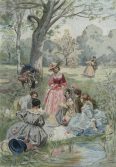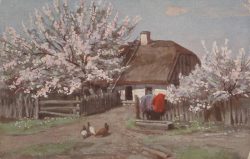 Blossoming nature has always awakened in people the desire to live, to spend time together and gave them more energy for various activities. Already in pre-Christian times, in many peoples in May, festivals associated with fertility and rebirth in full swing were celebrated lavishly. The Slavs also welcomed spring during this period with dances and outdoor games. May 1 was celebrated especially lavishly, for example, in the Zywiec Highlanders the erection of the so-called mojka took place. On the night of April 30 to May 1, a boy would put a spruce or fir tree decorated with ribbons, tissue paper and flowers in front of the house of a girl to whom he wanted to confess his feelings and serious intentions. Such a girl was obliged to organize a meeting with refreshments and dancing in the evening. "Mojka", however, could be an expression not only of appreciation, but also of anger or resentment. Then on the roof of the house a "grandfather" or a straw puppet dressed in rags was placed. If the bad emotions were directed toward the girl's parents, it also happened, for example, killing the front door of the house with boards or painting the windows. In the Bug River villages, on the first day of their maidenhood, girls who wanted to get married as soon as possible sang "konopielka," or wishful ritual songs.
Blossoming nature has always awakened in people the desire to live, to spend time together and gave them more energy for various activities. Already in pre-Christian times, in many peoples in May, festivals associated with fertility and rebirth in full swing were celebrated lavishly. The Slavs also welcomed spring during this period with dances and outdoor games. May 1 was celebrated especially lavishly, for example, in the Zywiec Highlanders the erection of the so-called mojka took place. On the night of April 30 to May 1, a boy would put a spruce or fir tree decorated with ribbons, tissue paper and flowers in front of the house of a girl to whom he wanted to confess his feelings and serious intentions. Such a girl was obliged to organize a meeting with refreshments and dancing in the evening. "Mojka", however, could be an expression not only of appreciation, but also of anger or resentment. Then on the roof of the house a "grandfather" or a straw puppet dressed in rags was placed. If the bad emotions were directed toward the girl's parents, it also happened, for example, killing the front door of the house with boards or painting the windows. In the Bug River villages, on the first day of their maidenhood, girls who wanted to get married as soon as possible sang "konopielka," or wishful ritual songs.
Lukasz Gołębiowski wrote interestingly about maypoles in his "Grach i zabawach" of 1831: "May, Mayówki or May strolls. This is a month of spring developed superbly; is it any wonder that it is devoted to merriment? Ancient peoples worshiped May as a goddess on the first day of the month, and her invocations and country dances have been preserved among the Greeks. It seems that she was also known to us to some extent. The Slavs used to welcome spring with songs and dances on the turf.""
Although it is a month associated with joy, dancing and love, it would even seem to be a dream month for arranging a wedding and reception. In tradition, however, it is regarded as the worst time to get married. Proverbs are associated with it: "who marries in May, quickly regrets", or "in May wedding, quick grave". It is difficult to find a clear explanation as to why this is so. The origins of the custom are traced by some to pre-Christian customs, then May was supposed to be another time of the year when the souls of the dead descended to earth and were not allowed to disturb them with lavish weddings. It is also said that one should not get married, in a month that does not have the letter "r" in its name. Here, too, the explanations are not simple. "R" can simply mean family, but more often to explain the reason researchers go back to the Middle Ages. Back then, they used mainly Latin and Latin names of months. In this language, only the summer months from May to August do not have an "R" in their name. However, it is not the letter that is at issue here, but the fact that summer was a time of strenuous work in the fields and on the farms, and for this, how mundane, reason our ancestors postponed weddings to another time.
May 1 Labor Day - the celebration of this joyous holiday was made up of many different traditions: Celtic, Norse and Greek. In centuries past, this day marked the beginning of the shepherding season. Processions of shepherds herding their cattle onto fresh grass for the first time would then travel through the villages; great cleansing ceremonies were held on the eve. In Celtic tradition, the night of April 30-May 1 marks the feast of Beltaine, the lighting of a great ritual bonfire, and in German Walpurgis Night, a witches' sabbath held on Mount Brocken. This was the most famous night in the history of European magic, described in both Goethe's Faust, Bulgakov's The Master and Margarita and James Joyce's Ulysses. The pagan ceremonies of Walpurgis Night and Beltaine were concerned with protection from spells and witches.
 On the first May evening, and later and on the following Saturday evenings in May, the villages along the Bug and Narew rivers would resound with "konopielka," songs of girls dreaming of marriage. Later, girls would arrange singing evenings for themselves at roadside crosses, where they sang about garlands, young men, and, in time, religious songs. Married women, on the other hand, would meet in the meadow on the first days of May, form a circle for fun, prancing around and humming "fond praises of spring."
On the first May evening, and later and on the following Saturday evenings in May, the villages along the Bug and Narew rivers would resound with "konopielka," songs of girls dreaming of marriage. Later, girls would arrange singing evenings for themselves at roadside crosses, where they sang about garlands, young men, and, in time, religious songs. Married women, on the other hand, would meet in the meadow on the first days of May, form a circle for fun, prancing around and humming "fond praises of spring."
May has long maintained various fun traditions. Among the common customs were school trips to May Day, the so-called spring recreation. On that day, excursions were organized, for example, to a nearby manor, where a hospitable nobleman, treated everyone to: dairy, dumplings, beer and homemade gingerbread. Some Polish lords set aside entire manors to entertain schoolchildren. In the evening, with singing and music, they would return home.
Finally came 1890, where workers brought rebellion, demonstrations, and banners to the May Day games. First in Warsaw, then in Cracow, First May parades started; in the following years they also appeared in other Polish cities. Nevertheless, the tradition of leisure on the first days of May and many of the rituals associated with them have survived to this day.
Sources:
- Gołębiowski Ł., Gry i zabawy różnych stanów w kraju całego lub niektórych tylko prowincjicyach : placed here: kulig czyli szlichtada, łowy, maskary, muzyka, tańce, reduty, zapusty, ognie sztuczne, rusałki, sobótki..., Warsaw 1831
- Kamocki J., Polski rok obrzędowy, Kraków 2008
- Ogrodowska B., Polskie obrzędy i zwyczaje doroczne, Warsaw 2009
- May 1 and... a bizarre blending of traditions, text available online: http://www.polskokatolicki.pl/RODZINA/2012_05/1_maja_swieto_ludowe.htm
Photo: polona.pl - public domain

